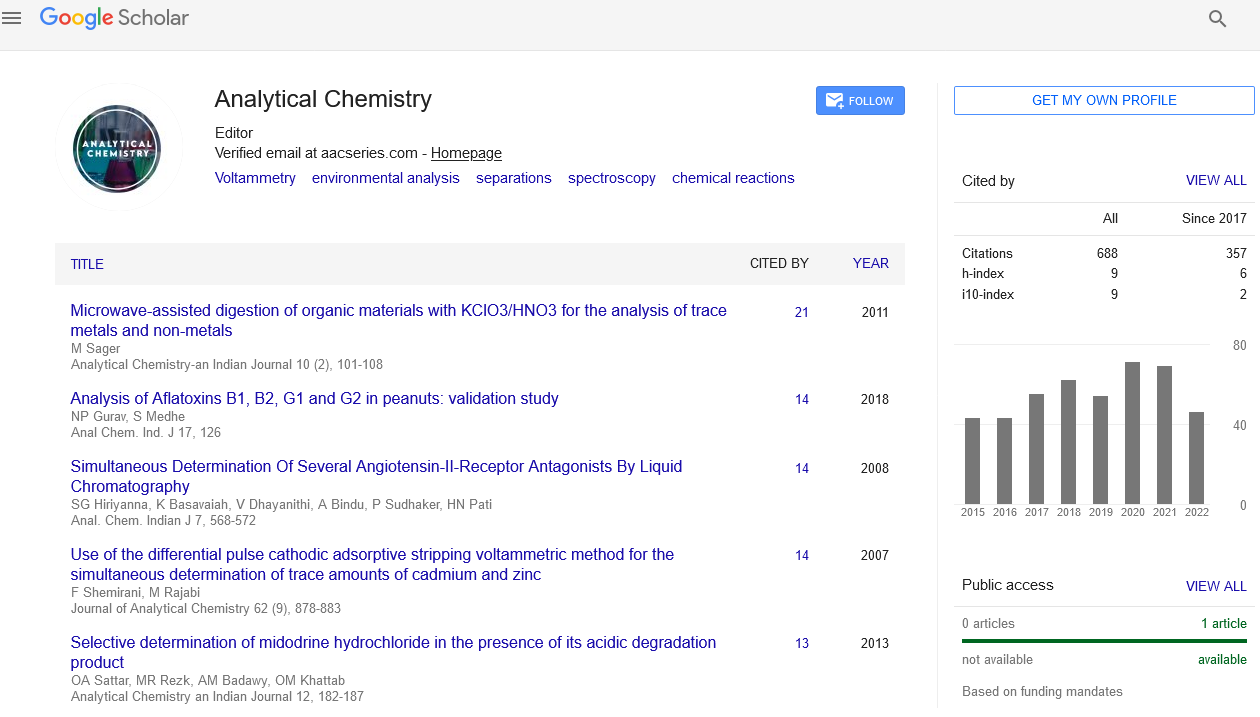Original Article
, Volume: 22( 4) DOI: DOI: 10.37532/0974- 7419.2022.22(4).192Proteomics and its analysis
- *Correspondence:
- Tim JasonManaging Editor, Analytical Chemistry: An Indian Journal, Brussels, Belgium., E-mail: timjason785@hotmail.com
Received: 04-Apr-2022, Manuscript No TSAC-22-79558; Editor assigned: 06-Apr-2022, PreQC No. TSAC-22-79558 (PQ); Reviewed: 20-Apr2022, QC No. TSAC-22-79558 (Q); Revised: 22-Apr-2022, Manuscript No TSAC-22-79558 (R); Published: 24-Apr-2022. DOI: 10.37532/0974- 7419.2022.22(4).192
Citation: Jason T. Proteomics and its analysis. Anal Chem Ind J. 2022;22(4):192
Abstract
A change in the content of the cerebrospinal fluid (CSF), which is released by a number of distinct central nervous system (CNS) structures, will properly represent pathological events. Proteomics provides a thorough system-level perspective for analyzing CSF proteins. In this work, a number of analytical techniques, including sample preparation, two-dimensional liquid and gel electrophoresis, mass spectrometry, bioinformatics, and non-gel approaches are reviewed. In the postgenomic age, it is still very difficult to measure the characteristics of endogenous cell proteins on a full proteome level, including expression level, subcellular localization, and turnover rates. The levels of relevant proteins cannot be predicted quantitatively, and there is little or no information on other protein characteristics.
Keywords
Bioanalysis; Bioinformatics; cerebrospinal fluid
Introduction
Proteins can be controlled by cells by phosphorylation and other reversible changes, as well as through modifying the pace of protein production and/or breakdown. For the measurement of gene expression at the RNA level, DNA microarrays are frequently utilized. Although high protein levels are typically a result of plentiful mRNAs, the relationship between mRNA levels and protein abundance is frequently poorly correlated.The significance of direct monitoring of protein levels is highlighted by the regulatory intricacy of mRNA translation and protein stability. Thepreferred method for investigating proteins directly is mass spectrometry-based proteomics, which enables quantitative comparisons of how relative protein levels vary in cells under various conditions as well as the identification of proteins and post-translational changes.
CSF leaks down around the spinal cord during the day. Small molecules, salts, peptides, proteins, enzymes, and other substances found in CSF are essential to numerous physiological functions. CSF provides a unique window to research CNS illnesses because changes (concentration; alteration of proteins and peptides) in its composition precisely reflect.
The number of dots dropped and they became easier to discern from that background as protein spots. When the CSF sample was prefractionated using a Bio-Spin column, the 2D gel was clearer and more spots were found. Because of this, salt removal using a Bio-Spin column was recommended. The enhanced gel and its high protein recovery level resolution.
Conclusion
Even though a lot of research has gone into the proteomics analysis of CSF, there is still more that can be done to more effectively identify PTM CSF proteins, discover low-abundance proteins, and preferentially eliminate high-abundance proteins. A more thorough understanding of the fundamental molecular mechanisms underlying a number of CNS illnesses will be made possible by this research effort.
We anticipate that this broad method for assessing protein turnover and related protein features can be expanded in a number of different ways in the future. The subcellular distribution of the proteome and how this connects with protein structure, isoforms, and PTM patterns can be better understood by expanding the subcellular fractionation technique, for instance, and obtaining higher-resolution spatial information. The proteome of the subjects in our current investigation has not shown any clear effects. Various cell cycle phases of developing cells.

